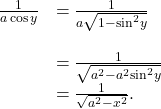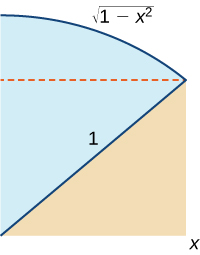41
Learning Objectives
- Integrate functions resulting in inverse trigonometric functions
In this section we focus on integrals that result in inverse trigonometric functions. We have worked with these functions before. Recall from Functions and Graphs that trigonometric functions are not one-to-one unless the domains are restricted. When working with inverses of trigonometric functions, we always need to be careful to take these restrictions into account. Also in Derivatives , we developed formulas for derivatives of inverse trigonometric functions. The formulas developed there give rise directly to integration formulas involving inverse trigonometric functions.
Integrals that Result in Inverse Sine Functions
Let us begin this last section of the chapter with the three formulas. Along with these formulas, we use substitution to evaluate the integrals. We prove the formula for the inverse sine integral.
Rule: Integration Formulas Resulting in Inverse Trigonometric Functions
The following integration formulas yield inverse trigonometric functions:
Proof
Let ![]() Then
Then ![]() Now let’s use implicit differentiation. We obtain
Now let’s use implicit differentiation. We obtain

For ![]() Thus, applying the Pythagorean identity
Thus, applying the Pythagorean identity ![]() we have
we have ![]() This gives
This gives

Then for ![]() we have
we have
□
Evaluating a Definite Integral Using Inverse Trigonometric Functions
Evaluate the definite integral ![]()
We can go directly to the formula for the antiderivative in the rule on integration formulas resulting in inverse trigonometric functions, and then evaluate the definite integral. We have

Find the antiderivative of ![]()
Solution
![]()
Finding an Antiderivative Involving an Inverse Trigonometric Function
Evaluate the integral ![]()
Substitute ![]() Then
Then ![]() and we have
and we have
Applying the formula with ![]() we obtain
we obtain

Find the indefinite integral using an inverse trigonometric function and substitution for ![]()
Solution
![]()
Hint
Use the formula in the rule on integration formulas resulting in inverse trigonometric functions.
Evaluating a Definite Integral
Evaluate the definite integral ![]()
Solution
The format of the problem matches the inverse sine formula. Thus,
![Rendered by QuickLaTeX.com \begin{array}{cc}\\ \\ {\int }_{0}^{\sqrt{3}\text{/}2}\frac{du}{\sqrt{1-{u}^{2}}}\hfill & ={ \sin }^{-1}u{|}_{0}^{\sqrt{3}\text{/}2}\hfill \\ & =\left[{ \sin }^{-1}(\frac{\sqrt{3}}{2})\right]-\left[{ \sin }^{-1}(0)\right]\hfill \\ & =\frac{\pi }{3}.\hfill \end{array}](https://opentextbooks.clemson.edu/app/uploads/quicklatex/quicklatex.com-8ea60a375c2fa0de928df6b007820f1a_l3.png)
Integrals Resulting in Other Inverse Trigonometric Functions
There are six inverse trigonometric functions. However, only three integration formulas are noted in the rule on integration formulas resulting in inverse trigonometric functions because the remaining three are negative versions of the ones we use. The only difference is whether the integrand is positive or negative. Rather than memorizing three more formulas, if the integrand is negative, simply factor out -1 and evaluate the integral using one of the formulas already provided. To close this section, we examine one more formula: the integral resulting in the inverse tangent function.
Finding an Antiderivative Involving the Inverse Tangent Function
Find an antiderivative of ![]()
Solution
Comparing this problem with the formulas stated in the rule on integration formulas resulting in inverse trigonometric functions, the integrand looks similar to the formula for ![]() So we use substitution, letting
So we use substitution, letting ![]() then
then ![]() and
and ![]() Then, we have
Then, we have
Use substitution to find the antiderivative of ![]()
Solution
![]()
Hint
Use the solving strategy from (Figure) and the rule on integration formulas resulting in inverse trigonometric functions.
Applying the Integration Formulas
Find the antiderivative of ![]()
Apply the formula with ![]() Then,
Then,
Evaluating a Definite Integral
Evaluate the definite integral ![]()
Solution
Use the formula for the inverse tangent. We have
![Rendered by QuickLaTeX.com \begin{array}{cc}\\ \\ {\int }_{\sqrt{3}\text{/}3}^{\sqrt{3}}\frac{dx}{1+{x}^{2}}\hfill & ={ \tan }^{-1}x{|}_{\sqrt{3}\text{/}3}^{\sqrt{3}}\hfill \\ & =\left[{ \tan }^{-1}(\sqrt{3})\right]-\left[{ \tan }^{-1}(\frac{\sqrt{3}}{3})\right]\hfill \\ & =\frac{\pi }{6}.\hfill \end{array}](https://opentextbooks.clemson.edu/app/uploads/quicklatex/quicklatex.com-c90feb4e99308f37c1110c929a48e820_l3.png)
Evaluate the definite integral ![]()
Solution
![]()
Hint
Follow the procedures from (Figure) to solve the problem.
Key Concepts
- Formulas for derivatives of inverse trigonometric functions developed in Derivatives of Exponential and Logarithmic Functions lead directly to integration formulas involving inverse trigonometric functions.
- Use the formulas listed in the rule on integration formulas resulting in inverse trigonometric functions to match up the correct format and make alterations as necessary to solve the problem.
- Substitution is often required to put the integrand in the correct form.
Key Equations
- Integrals That Produce Inverse Trigonometric Functions



In the following exercises, evaluate each integral in terms of an inverse trigonometric function.
1. ![]()
Solution
![]()
2. ![]()
3. ![]()
Solution
![]()
4. ![]()
5. ![]()
Solution
![]()
6. ![]()
In the following exercises, find each indefinite integral, using appropriate substitutions.
7. ![]()
8. ![]()
9. ![]()
Solution
![]()
10. ![]()
11. ![]()
Solution
![]()
12. ![]()
13. Explain the relationship ![]() Is it true, in general, that
Is it true, in general, that ![]()
Solution
![]() So,
So, ![]() They differ by a constant.
They differ by a constant.
14. Explain the relationship ![]() Is it true, in general, that
Is it true, in general, that ![]()
15. Explain what is wrong with the following integral: ![]()
Solution
![]() is not defined as a real number when
is not defined as a real number when ![]()
16. Explain what is wrong with the following integral: ![]()
In the following exercises, solve for the antiderivative ![]() of
of ![]() with
with ![]() then use a calculator to graph
then use a calculator to graph ![]() and the antiderivative over the given interval
and the antiderivative over the given interval ![]() Identify a value of C such that adding C to the antiderivative recovers the definite integral
Identify a value of C such that adding C to the antiderivative recovers the definite integral ![]()
17. [T] ![]() over
over ![]()
Solution

The antiderivative is ![]() Taking
Taking ![]() recovers the definite integral.
recovers the definite integral.
18. [T] ![]() over
over ![]()
19. [T] ![]() over
over ![]()
Solution
![Two graphs. The first shows the function f(x) = cos(x) / (4 + sin(x)^2). It is an oscillating function over [-6, 6] with turning points at roughly (-3, -2.5), (0, .25), and (3, -2.5), where (0,.25) is a local max and the others are local mins. The second shows the function F(x) = .5 * arctan(.5*sin(x)), which also oscillates over [-6,6]. It has turning points at roughly (-4.5, .25), (-1.5, -.25), (1.5, .25), and (4.5, -.25).](https://s3-us-west-2.amazonaws.com/courses-images/wp-content/uploads/sites/2332/2018/01/11204305/CNX_Calc_Figure_05_07_203.jpg)
The antiderivative is ![]() Taking
Taking ![]() recovers the definite integral.
recovers the definite integral.
20. [T] ![]() over
over ![]()
In the following exercises, compute the antiderivative using appropriate substitutions.
21. ![]()
Solution
![]()
22. ![]()
23. ![]()
Solution
![]()
24. ![]()
25. ![]()
Solution
![]()
26. ![]()
In the following exercises, use a calculator to graph the antiderivative ![]() with
with ![]() over the given interval
over the given interval ![]() Approximate a value of C , if possible, such that adding C to the antiderivative gives the same value as the definite integral
Approximate a value of C , if possible, such that adding C to the antiderivative gives the same value as the definite integral ![]()
27. [T] ![]() over
over ![]()
Solution

The antiderivative is ![]() Taking
Taking ![]() recovers the definite integral over
recovers the definite integral over ![]()
28. [T] ![]() over
over ![]()
29. [T] ![]() over
over ![]()
![The graph of f(x) = arctan(x sin(x)) over [-6,6]. It has five turning points at roughly (-5, -1.5), (-2,1), (0,0), (2,1), and (5,-1.5).](https://s3-us-west-2.amazonaws.com/courses-images/wp-content/uploads/sites/2332/2018/01/11204310/CNX_Calc_Figure_05_07_207.jpg)
The general antiderivative is ![]() Taking
Taking ![]() recovers the definite integral.
recovers the definite integral.
30. [T] ![]() over
over ![]()
31. [T] ![]() over
over ![]()
![A graph of the function f(x) = arctan(ln(x)) over (0, 2]. It is an increasing curve with x-intercept at (1,0).](https://s3-us-west-2.amazonaws.com/courses-images/wp-content/uploads/sites/2332/2018/01/11204313/CNX_Calc_Figure_05_07_209.jpg)
The general antiderivative is ![]() Taking
Taking ![]() recovers the definite integral.
recovers the definite integral.
32. [T] ![]() over
over ![]()
In the following exercises, compute each integral using appropriate substitutions.
33. ![]()
Solution
![]()
34. ![]()
35. ![]()
Solution
![]()
36. ![]()
37. ![]()
Solution
![]()
38. ![]()
In the following exercises, compute each definite integral.
39. ![]()
40. ![]()
41. ![]()
Solution
![]()
42. ![]()
43. For ![]() compute
compute ![]() and evaluate
and evaluate ![]() the area under the graph of
the area under the graph of ![]() on
on ![]()
Solution
![]() as
as ![]()
44. For ![]() compute
compute ![]() and evaluate
and evaluate ![]() the area under the graph of
the area under the graph of ![]() over
over ![]()
45. Use the substitution ![]() and the identity
and the identity ![]() to evaluate
to evaluate ![]() ( Hint: Multiply the top and bottom of the integrand by
( Hint: Multiply the top and bottom of the integrand by ![]() )
)
Solution
Using the hint, one has ![]() Set
Set ![]() Then,
Then, ![]() and the integral is
and the integral is ![]() If one uses the identity
If one uses the identity ![]() then this can also be written
then this can also be written ![]()
46. [T] Approximate the points at which the graphs of ![]() and
and ![]() intersect, and approximate the area between their graphs accurate to three decimal places.
intersect, and approximate the area between their graphs accurate to three decimal places.
47. [T] Approximate the points at which the graphs of ![]() and
and ![]() intersect, and approximate the area between their graphs accurate to three decimal places.
intersect, and approximate the area between their graphs accurate to three decimal places.
Solution
![]() The left endpoint estimate with
The left endpoint estimate with ![]() is 2.796 and these decimals persist for
is 2.796 and these decimals persist for ![]()
48. Use the following graph to prove that ![]()



Hint
Substitute